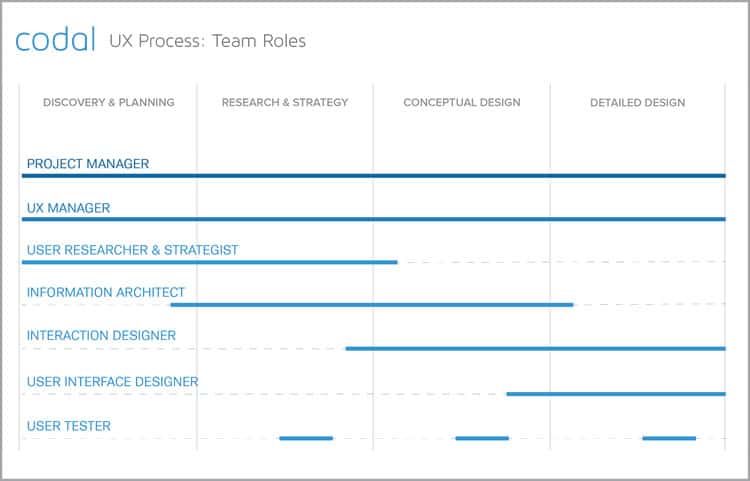A “typical” user experience process follows a general rule of thumb: discovery, research, conceptual design (this is where wireframes are designed), and detailed design.
At these different stages, the chances are that you will have different people working on each part of the project. The graph below shows which UX roles are involved in which stages of the experience design process at the company where I work, Codal:

After a client approves the final mockup of the detailed design, the user experience designer’s job is complete, right?
Not at all.
At most agencies, and throughout most freelance work, the UX designer typically stops contributing to the project when the client approves the final mockup. However, we have extended the role of the UX designer to go beyond that.
Although it would seem fair that designers do what their job title suggests, it is not representative of their true responsibilities.
Back to the Basics
Let us go back to defining what user experience really is. What makes a good user experience design? The term user experience encircles everything that the end-user interacts with: the company and the company’s services or products. It is the overall experience that the user has on the website or mobile application.
The user experience designer’s job is to ensure that the user can find what they are looking for and that the platform flows properly, which means they must have a positive encounter on the digital platform.
However, the UX design stage is typically only half of every project. The second phase of a typical project is in the hands of a group of developers, who do not always have an eye for design or even usability.
What else can Affect the User Experience?
Things like domain name, website speed, use of plugins, missing design assets, and broken links, can all affect the end user’s experience with a website.
It is believed that 53% of mobile users will abandon a site that takes more than 3 seconds to load. This statistic gives us no doubt that the speed of a website can alter the user experience on a website.
Some developers will use a plugin instead of custom coding a particular feature, like a blog in a grid layout for example. Plugins can easily break and will make that part of your website stop working.
A blog is just one functionality example. What about an API that stops working, and your users cannot fill out your form. Functionality issues directly alter your user’s experience.
Even things that people do not think about, like a domain name, can directly change the experience of navigating to a website. Imagine having to type “Codaluserexperienceagency.com” versus just “codal.com” into your search engine.
Lastly, having an array of stock photos on your site can change the experience. However, this is not something that the designer always has a choice on. In this situation, the designer should design with as little images as possible.
This bad UX (user experience) can easily result in lost conversions or angry customers. To ensure that this does not happen, UX designers must always make themselves available during every phase of product development.
The User Experience Designer Should Always be Present
Everything is part of the end user’s experience. This means that the UX designer who is assigned to that particular project needs to be present along the entire process, until launch.
The user experience designer’s job does not end at the end of the design phase.
For his or her design to be implemented correctly, they should be present while the project is in the hands of the developers. No one else knows and understands the design better than the person (or people) who created it.
When it comes to UX design and software development, collaboration is key. To ensure that the end product is exactly what they designed, and the functionality is up to par, the user experience designer must continuously communicate with the developer.
When the website or mobile application is being QA’d (the quality assurance stage) the user experience designer should be very active, making sure that the design was implemented in the way in which they visualised.
Just think, how many QA personnel are UX designers?
A quality assurance specialist is typically assigned to every project. However, they are not always aware of how the original design looked like. Very often, they are focused on making sure that the code is clean, and that everything is functioning the way that it should.
This is why that the user experience designer should work along side with the QA specialist, along with the developer.
Conclusion
The user experience designer has to be present during the entire lifecycle of any project that includes both a UX design and development phase.
For a user experience designer to have a successful end product, they have to be attentive, vigilant, and sometimes tough on all the team members involved in a project (but only when needed!).
As a user experience designer, involving yourself in every step of the process is not overstepping your boundary, it is mission-critical.
Source: Usability Geek
Author: Jenna Erickson

